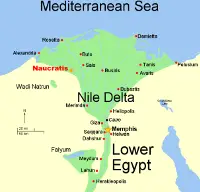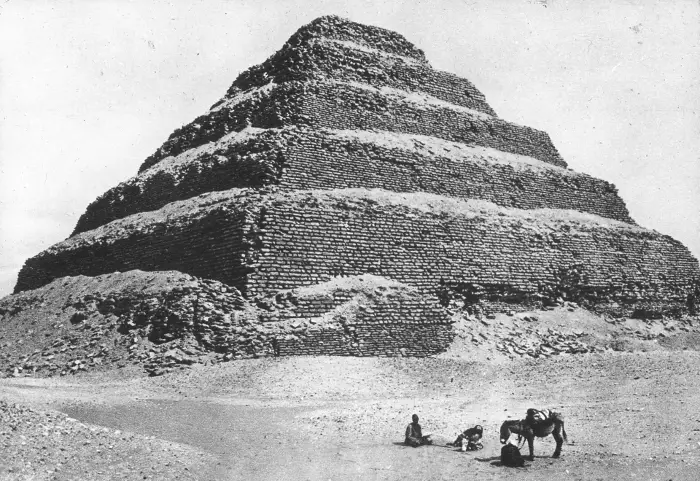Memphis: Powerhouse Capital of Ancient Egypt
Memphis was the capital of Ancient Egypt, for a great many years the largest city and the envy of the world. 
The name in the ancient Egyptian tongue was Ineb Hedj, meaning "The White Walls," in reference to the whitewashed brick of the walls (of either the royal palace or of the entire city, depending on the source). The Greeks corrupted the name of the pharaoh Pepi I's pyramid, Men-nefer, as first Menfe and then Memphis. Another name for Memphis in ancient times was Ankh Tawy, meaning "That which binds the Two Lands." The city's foundation at the mouth of the Nile Delta made the city an ideal strategic location for a city, trade center, and military presence. Some sources date the founding of Memphis to coincide with the rise of Narmer, the first ruler of all Egypt. Also referred to as Menes, he is thought by many to have lived in the 32nd Century B.C. More than one source says that he directed the city to be saved and For a brief period, the kings of Memphis moved the capital to Herakleopolis; it was the pharaoh Mentuhotep II who dismissed the kings of that city and unified Egypt, with the capital again at Memphis. Again a few short reigns later, the capital moved again, this time north to Iti-tawi. As before, Memphis continued to be a commercial and economic powerhouse. The Hyksos period in Egypt resulted in a large-scale takeover of much of Lower Egypt, including Memphis. Hyksos leaders for a time raided Memphis temples and carted off various statues, taking them back to the Hyksos capital, Avaris. It was Thebes that led the uprising that drove the Hyksos from Egypt. Memphis recovered some of its former glory and was again a favorite location for the kings to build their temples. During the 18th Dynasty, Thebes in the south was the Egyptian capital; also during this dynasty, the pharaoh Akhenaten moved the capital again, this time to Amarna (while also building in Memphis a temple to the sole god, Aten). His son and successor, Tutankhamen, re-anointed Memphis as the capital city. In the same way, Ramses II, while creating his own new capital city, Pi-Ramses, built a number of large monuments in Memphis. The city enjoyed supremacy in later years but was firmly supplanted by the rise of Alexandria.  Near Memphis was the large necropolis of Saqqara, which was the burial location for many of Egypt's kings, including the Step Pyramid of Djoser. Stretching from Saqqara to Giza, a distance of some 20 miles, were a line of pyramids. At Giza were the Great Pyramid and the Great Sphinx. Memphis, too, had a smaller sphinx, made of alabaster and stretching 13 feet high and 24 feet long. Memphis was a target for later invaders, notably the Assyrian kings Esarhaddon and Ashurbanipal, both of whom sacked the ancient capital in 671 and 666, respectively. The Persian king Cambyses took the city in 525 B.C. In turn, the conqueror of the Persian Empire, Alexander the Great, took control in 332 B.C., having himself crowned in Memphis and using it as his power base while perfecting the design for Alexandria. The later pharaoh Ptolemy I brought back Alexander's body to Memphis, where it stayed for a time before being moved to Alexandria and then disappearing. One of the most famous things to come out of Memphis was the Rosetta Stone, issued by Ptolemy V in 196 B.C. It was the last gasp for a once proud and world-beating city. When Rome annexed Egypt, the Romans declared Alexandria the most important city; Memphis faded away. |
|
Social Studies for Kids
copyright 2002–2024
David White



 be able to prosper by installing dikes to divert the river around the city. From such beginnings, Memphis grew to be the largest city in the world, a title that it held for several hundred years, as pharaoh after pharaoh made the city not only the royal capital but also a center of commerce, worship, enterprise, and reverence. Memphis was home to the Hout-ka-Ptah, a very large temple to the creator god Ptah.
be able to prosper by installing dikes to divert the river around the city. From such beginnings, Memphis grew to be the largest city in the world, a title that it held for several hundred years, as pharaoh after pharaoh made the city not only the royal capital but also a center of commerce, worship, enterprise, and reverence. Memphis was home to the Hout-ka-Ptah, a very large temple to the creator god Ptah.
